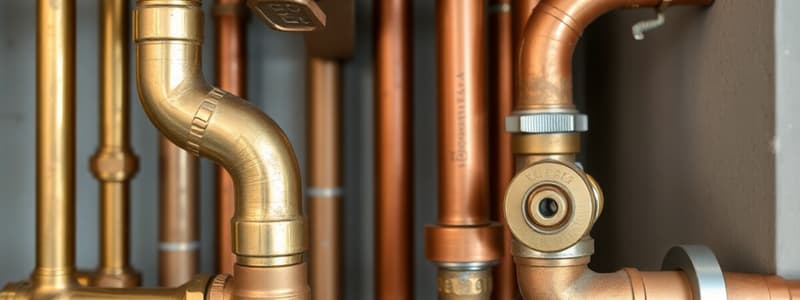Podcast
Questions and Answers
What is one of the primary materials that brass pipes are made from?
What is one of the primary materials that brass pipes are made from?
- Copper and tin
- Copper and zinc (correct)
- Zinc and aluminum
- Copper and lead
What characteristic makes brass pipes particularly suitable for hot water lines?
What characteristic makes brass pipes particularly suitable for hot water lines?
- Low thermal conductivity
- High resistance to corrosion (correct)
- Short lifespan
- Resistance to rust
Which of these is NOT a method for connecting brass pipes?
Which of these is NOT a method for connecting brass pipes?
- Soldering
- Brazing
- Compression fittings
- Pneumatic connections (correct)
What is a notable property of copper pipes related to its impact on water systems?
What is a notable property of copper pipes related to its impact on water systems?
Which size is NOT offered for brass pipes?
Which size is NOT offered for brass pipes?
Which of the following joint connections can be used with copper pipes?
Which of the following joint connections can be used with copper pipes?
What is the standard length for rigid copper pipes?
What is the standard length for rigid copper pipes?
What is a disadvantage of brass pipes compared to copper pipes?
What is a disadvantage of brass pipes compared to copper pipes?
What is the typical carbon content in black iron (BI) pipes?
What is the typical carbon content in black iron (BI) pipes?
Which type of joint connection is commonly used for asbestos cement pipes?
Which type of joint connection is commonly used for asbestos cement pipes?
What is the standard length of black iron pipes?
What is the standard length of black iron pipes?
Which of the following types of pipes is primarily used in storm drain lines and sewer systems?
Which of the following types of pipes is primarily used in storm drain lines and sewer systems?
What joint connection method is commonly used in concrete pipes?
What joint connection method is commonly used in concrete pipes?
What is a significant reason for phasing out lead pipes in plumbing?
What is a significant reason for phasing out lead pipes in plumbing?
What characteristic of cast iron contributes to its brittleness?
What characteristic of cast iron contributes to its brittleness?
Which joint connection method uses bolts to secure the connection?
Which joint connection method uses bolts to secure the connection?
Why are cast iron pipes preferred for city water-distribution systems?
Why are cast iron pipes preferred for city water-distribution systems?
What type of joint is formed by fitting the spigot of one pipe into the bell of another pipe?
What type of joint is formed by fitting the spigot of one pipe into the bell of another pipe?
What material is utilized in no-hub couplings to create a secure seal?
What material is utilized in no-hub couplings to create a secure seal?
Which property makes cast iron pipes suitable for sewage and drainage systems?
Which property makes cast iron pipes suitable for sewage and drainage systems?
What is a key advantage of lead pipes that contributed to their historical usage?
What is a key advantage of lead pipes that contributed to their historical usage?
Which joint connection method uses heat to fuse the pipe and fitting?
Which joint connection method uses heat to fuse the pipe and fitting?
What is a key advantage of PPR pipes compared to other types of pipes?
What is a key advantage of PPR pipes compared to other types of pipes?
What are the common outer diameters for PPR pipes?
What are the common outer diameters for PPR pipes?
What is the main material used for making metal pipes?
What is the main material used for making metal pipes?
What is a standard length for PPR pipes?
What is a standard length for PPR pipes?
What is the primary characteristic of LDPE pipes compared to HDPE pipes?
What is the primary characteristic of LDPE pipes compared to HDPE pipes?
Which joint connection method is NOT used for LDPE pipes?
Which joint connection method is NOT used for LDPE pipes?
What is a common application for HDPE pipes?
What is a common application for HDPE pipes?
Which size is a standard Outside Diameter (O.D.) for LDPE pipes?
Which size is a standard Outside Diameter (O.D.) for LDPE pipes?
What is the most common color for LDPE pipes used in the market?
What is the most common color for LDPE pipes used in the market?
Which joint connection method is shared by both LDPE and HDPE pipes?
Which joint connection method is shared by both LDPE and HDPE pipes?
What is true about the density of HDPE pipes compared to LDPE pipes?
What is true about the density of HDPE pipes compared to LDPE pipes?
What is NOT a standard length option for LDPE pipes?
What is NOT a standard length option for LDPE pipes?
Flashcards are hidden until you start studying
Study Notes
Brass Pipes
- Alloy of copper and zinc
- Highly resistant to corrosion, especially from water
- Long lifespan and can withstand high temperatures and pressures
- Brass has natural antimicrobial properties, which can help reduce bacterial growth in water systems
- Prevalent Use: Water supply line, particularly hot water lines
- Joint Connection Methods:
- Soldering
- Brazing
- Threaded Connections
- Compression Fittings
- Sizes: 1/2”, 3/4", 1”
- Standard Length: 6 meters
Copper Pipes
- Made of small diameter
- Durable because it is resistant to rust
- Has high thermal conductivity, allowing it to efficiently transfer heat
- Copper has natural antimicrobial properties, which can help reduce the growth of bacteria and pathogens in water systems
- Prevalent Use: Hot and cold water supply lines, drainage systems (Type DWV)
- Joint Connection Methods:
- Flared Connections
- Soldering
- Brazing
- Compression Fittings
- Sizes: 1/4", 3/8”, 1/2”, 3/4", 1”, 2”
- Standard Length: 6 meters (rigid pipe), 30 meters (coil)
LDPE Pipes
- Soft and flexible type of polyethylene with lower density
- Used for low-pressure applications
- Lower melting point
- Color: Black (most common in the market), Blue (potable water)
- Prevalent Use: Low pressure water distribution line, and irrigation
- Joint Connection Methods:
- Compression Fittings
- Barbed Fittings
- Push-fit Fittings
- Butt Fusion Welding
- Electrofusion
- Sizes: Outside Diameter (O.D.) - 1/2", 3/4”, 1”, 1-1/4”, 1-1/2”, 2”
- Standard Length: 50 meters, 100 meters, 200 meters (coils); 6 meters (straight lengths for larger diameters)
HDPE Pipes
- Stronger and more rigid material with a higher density compared to LDPE
- Resistant to a range of chemicals and environmental conditions
- Commonly used for industrial settings, suitable for fluid and gas transfer
- Color: Black (often with blue stripes to indicate they are used for potable water supply)
- Prevalent Use: Commonly used in sewer and stormwater drainage systems because of their resistance to chemical attacks and abrasion, or high-pressure water supply lines
- Joint Connection Methods:
- Butt Fusion Welding
- Electrofusion
- Mechanical Fittings
- Socket Fusion
- Sizes: Outside Diameter (O.D.) - 1/2", 3/4”, 1”, 1-1/4”, 1-1/2”, 2”, 3”, 4”, 6”, 8”, 10”, 12”
- Standard Length: 50 meters, 100 meters, 200 meters (coils); 6 meters, 12 meters (straight lengths for larger diameters)
PPR Pipes (Polypropylene Random Copolymer)
- High resistance to pressure and temperature fluctuations
- Resistant to chemicals and corrosion
- PPR pipes have low thermal conductivity, which minimizes heat loss in hot water systems
- Color: Commonly white with stripe coloring, or green
- Prevalent Use: Hot and Cold water supply line
- Joint Connection Methods:
- Socket Fusion Weld
- Butt Fusion
- Sizes: Outer Diameter - 20mm, 25mm, 32mm (1/2”, 3/4", 1”)
- Standard Length: 4 meters
Lead Pipe
- Historically, lead pipes were widely used in plumbing systems, particularly for water supply and drainage
- High corrosion resistance, flexibility, and hydraulic coefficient of flow
- Lead content in water can lead to poisoning effects that are harmful to people, thus, it is not preferred. Due to health concerns, many countries have phased out the use of lead pipes
- Connected using means of a wiped tuft joint
Cast Iron (CI) Pipes
- Made up of alloy of iron and carbon (2 - 3.5%)
- The carbon content that gives cast iron its rough, slightly bumpy feel. Its higher carbon content makes cast iron more brittle than steel (which is why it needs to be so heavy and thick)
- Cast iron pipes are strong, durable pipes made from molten cast iron that is poured into molds
- Cast iron pipes are heavy and rigid, making them suitable for applications where strength and longevity are required
- Used for city water-distribution systems due to its high resistance to corrosion and consequent long life
- Prevalent Use: Sewage and Drainage System
- Joint Connection Methods:
- Bell and Spigot
- Mechanical Joints
- Flanged Joints
- No-Hub (Hubless) Couplings
Black Iron (BI) Pipes
- Made from low carbon steel, which typically contains 0.05% to 0.25% carbon
- Good balance between strength and ductility
- Prevalent Use: Water supply line, gas line, and fire suppression system
- Joint Connection Methods:
- Threaded Connections
- Welded Connections
- Flanged Connections
- Sizes: Outside Diameter – 1/2", 3/4", 1”, 1-1/4”, 1-1/2”, 2”, 2-1/2”, 3”, 4”, 5” 6”, 8”, 10”, 12”
- Standard Length: 6 meters
Asbestos Cement Pipe
- Made from silica, asbestos, and cement converted under pressure into a dense, homogeneous material possessing considerable strength
- Prevalent Use: Water supply line, and drainage systems
- Joint Connection Methods:
- Bell and Spigot Joint
- Mechanical Coupling Joints
- Sizes: Outside Diameter – 4”, 5”, 6” 8”, 10”, 12”
- Standard Length: 6 meters
Concrete Pipes
- Cylindrical pipes made from concrete, can be reinforced (using steel bars or mesh) to enhance their structural integrity, especially for heavy load applications
- Pre-casted pipes
- Prevalent Use: Storm drain line, sewer systems, culvert
- Joint Connection Methods:
- Mortar Joints
- Sizes: Outside Diameter – 4”, 5”, 6” 8”, 10”, 12”
- Standard Length: 2 meters
Studying That Suits You
Use AI to generate personalized quizzes and flashcards to suit your learning preferences.




